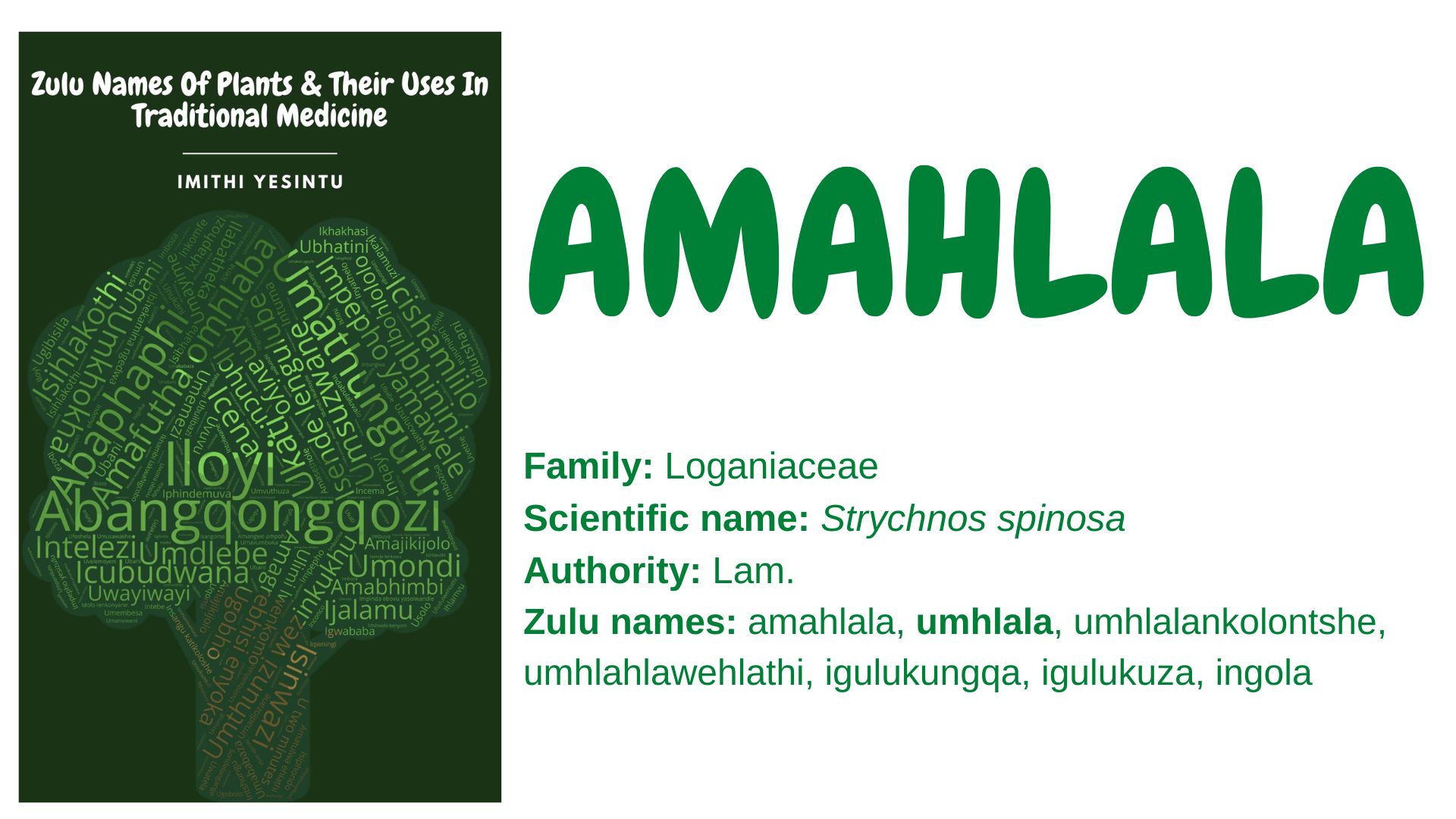Family: Loganiaceae
Scientific name: Strychnos spinosa
Authority: Lam.
Synonyms Brehmia spinosa (Lam.) Harv.
Zulu names: amahlala, umhlala, ihlala, umhlalankolontshe, umhlahlawehlathi, igulukungqa, igulukuza, ingola
Other names: African orange, bush orange, spiny monkey orange, sweet monkey orange (English) kaffir orange, klapper, klapperboom, klappers, wildekalabasboom (Afrikaans)
Plant description: S. spinosa is a deciduous shrub that grows to between 5 to 6 m in height. It has simple, ovale, and opposite leaves, greenish white flowers, and edible globular fruits that turn yellow when ripe containing several seeds covered by edible pulp. The shrub can be found all over Africa and commonly occurs in the savanna and well open and degraded forest habitats.
Uses:
- The pulp of ripe fruits are eaten as food.
- The fruits are used to make an infusion that is taken with porridge to treat postpartum pain.
- The fruits are used to treat inflammation. The powder from the charred fruit is rubbed into the incisions to treat swollen testicles.
- The fruits are used to treat warts.
- The roots are mixed with those of Leonotis leonurus along with other plants that are considered as isihlungu (snake antidote) to treat snake bites. The crushed seeds and green fruit can also be added to a mixture that is used to treat snake bites.
- The roots and green fruit are used to treat fever.
- The roots and green fruit are used to treat sore eyes.
- The roots can be administered as an emetic.
- The roots are used as a dewormer and to treat parasitic infections, such as intestinal worms.
- The roots are used to treat gastrointestinal disorders.
- The roots are used to treat STDs and tuberculosis.
- The roots are mixed with those of Tacca leontopetaloides (L). Kuntze, the mixture is used to treat diabetes mellitus.
- The leaves are used to make poultice that is applied on the skin to treat scabies.
- The leaves are used to treat reproductive issues in women such as excessive and irregular menstruations.
- The leaves are used to treat sores.
- The plant is used to treat reproductive disorders in men such as impotence, loss of virility, and infertility.
- The plant is also used to treat microbial infections, malaria, hypertension, and trypanosomiasis.
Safety precaution:
Using traditional medicine responsibly can enhance your overall health and well-being. Misuse and abuse can lead to complications. You can inquire about the correct use of traditional medicine from a knowledgeable herbalist and practitioner. You can also visit imithiyesintu.co.za or email: info@imithiyesintu.co.za to learn more about traditional medicine
References and further reading:
- Akoégninou, A., van der Burg, W.J., van der Maesen, L.J.G, Adjakidjè, V., Essou, J.P., Sinsin, B., and Yédomonhan, H. (Eds.). 2006.. Flore analytique du Bénin. (Wageningen Agricultural University papers (6)2. Leiden: Backhuys Publishers
- Asase, A., Oteng-Yeboah, A.A., Odamtten, G.T. and Simmonds, M.S., 2005. Ethnobotanical study of some Ghanaian anti-malarial plants. Journal of Ethnopharmacology, 99(2), pp.273-279.
- Boon, R. and Pooley, E., 2010. Pooley’s trees of eastern South Africa. Flora and Fauna Publications Trust.
- Bryant, A.T., 1966. Zulu medicine and medicine men. C. Struik, Cape Town (originally published in 1909 in the Annals of Natal Museum).
- De Wet, H., Nciki, S., and Van Vuuren, S.F., 2013. Medicinal plants used for the treatment of various skin disorders by a rural community in northern Maputaland, South Africa. Journal of Ethnobiology and Ethnomedicine 9(51).
- Fox, F.W., and Norwood Young, M.E., 1982. Food from the veld. Delta Books, Johannesburg.
- Gerstner, J., 1939. A preliminary checklist Zulu names of plants with short notes. Bantu Studies 13 (1).
- Jenkins, M.D. (Ed.), 1987. Madagascar: An environmental profile. IUCN, Gland, Switzerland.
- Karou, S.D., Tchacondo, T., Djikpo Tchibozo, M.A., Abdoul-Rahaman, S., Anani, K., Koudouvo, K., Batawila, K., Agbonon, A., Simpore, J. and de Souza, C., 2011. Ethnobotanical study of medicinal plants used in the management of diabetes mellitus and hypertension in the Central Region of Togo. Pharmaceutical biology, 49(12), pp.1286-1297.
- Mabogo., D.E.N., 1990. The ethnobotany of the VhaVenda. M.Sc. dissertation, University of Pretoria, Pretoria.
- Maroyi, A., 2011. An ethnobotanical survey of medicinal plants used by the people in Nhema communal area, Zimbabwe. Journal of ethnopharmacology, 136(2), pp.347-354.
- Nciki, S., Van Vuuren, S., Van Eyk, A., and De Wet, H., 2016. Plants used to treat skin diseases in northern Maputaland, South Africa: antimicrobial activity and in vitro permeability studies. Journal of Pharmaceutical Biology 6, pp. 2420–2436
- Oliver-Bever, B., 1986. Medicinal plants in tropical West Africa. Cambridge University Press, London.
- Tittikpina, N.K., Atakpama, W., Hoekou, Y., Diop, Y.M., Batawila, K. and Akapagana, K., 2020. Strychnos spinosa Lam: comprehensive review on its medicinal and nutritional uses. African Journal of Traditional, Complementary and Alternative Medicines, 17(2), pp.8-28.
- Van Wyk, B.E., and Gericke, N., 2000. People’s plants. A guide to useful plants of southern Africa. Briza Publications, Pretoria.
- Walker, J., 1996. Wild flowers of KwaZulu-Natal. W.R. Walker Family Trust, Pinetown.
- Watt, J.M., and Breyer-Brandwijk, M.G., 1962. Medicinal and poisonous plants of southern and eastern Africa, second edition. Livingstone, London.
You Can Order Your Copy Of The Book By Emailing: info@imithiyesintu.co.za
Feel Free To Add Other Uses Of This Plant In The Comment Section Below:
